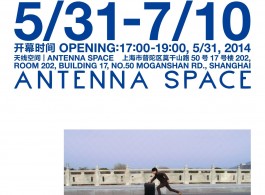[Press Release]
Opening:5pm.-7pm., 5/31, 2014
Address: ANTENNA SPACE, Room 202, Building 17, No.50 Moganshan Rd., Shanghai
Antenna Space is honored to present Meditation, the solo exhibition of experimental video artist Li Ming. Li Ming’s works usually originate from a certain image, word, action or atmosphere that provoks his interest. However, from a certain period, intuition and spontaneity are no longer his first choices to rely on – he has to break the chains.
The difference between The Mediation and his previous exhibitions is that, Li Ming begins to think about the possible reasons and extensions of his motivations that are beyond sensitivities. Also, during the procedure of making and presenting his works, he intentionally applied the “artificial elements” and left the traces. Take MOVEMENTS as an example. In the exhibition room, we see an artist who is surrounded with his own images, running on a timeline that is seemingly endless but at the same time staying still at the present. His chase is not only simultaneous but also time-lapse. If the video art was inborn with features like narcissism, reflection and immediacy (the subject-object relation cancelled, space squeezed and the continuity of time severed) as well as the criticism for these features, the problems emerge again in MOVEMENTS. As a result, in the last time of the shooting, the artist simply kept running, even if there is no longer a specific object for him to chase after. If the body of the artist in MOVEMENTS works as a tool and functions as a connection, then in ZOOM, it was hidden behind the tool/equipment. Li Ming set out from the terrace of his house, where he focused the camera onto a place as far as possible, and then went to reach the place in person. He then would start from the place again to the next destination, repeating the pattern all the way until he arrived in Shanghai. LIGHTERS reveals the “back stage”, where the distancing of the camera hinders the audience from going further and sharing the pleasure of destroying together with the artist. The intended hindrance and distancing are more similar to a metaphor, which is also a gap that the exhibition leaves us – the uncertainty of the connection between art and the reality, and of whether the efforts made by art towards its audience worked.
In fact, to Li Ming, video has never only been a medium for documenting actions, nor it is his ambition for filmmaking. The artist’s body has always been used as a mediator bridging the performance and the video. The involvement of the artist’s body has been a key feature that differentiates video art from other visual art forms since its birth. It also serves as the starting point of many early video artists. Although the media of today’s contemporary art are becoming more and more comprehensive, which makes the obsession with linear researches for a specific medium seem not “contemporary” enough. However, according to Benjamin, a medium will show again its initial potentiality when it goes to an end, making this revisit meaningful. Also to the artist himself, this is a clarification of the threads throughout his creative production.
LI Ming was born in Yuan Jiang, Hunan Province, 1986. He graduated from China Academy of Art in 2008 and currently works and lives in Hangzhou. His recent exhibitions include:
The 8th Shenzhen Sculpture Biennale: We have never participated, Shenzhen OCAT Contemporary Art Terminal, Shenzhen, 2014;
Pandamonium – Media Art from Shanghai, Momentum, Berlin, Germany, 2014;
The Popular Tree and Mirror, ISCP, New York, the United States, 2014;
28 Chinese – Rubell family collection, Miami Art Museum, Miami, the United States, 2013;
Degeneration, OCAT Shanghai, Shanghai, 2013;
ON|OFF: China’s Young Artists in Concept and Practice, UCCA, Beijing, 2013.



